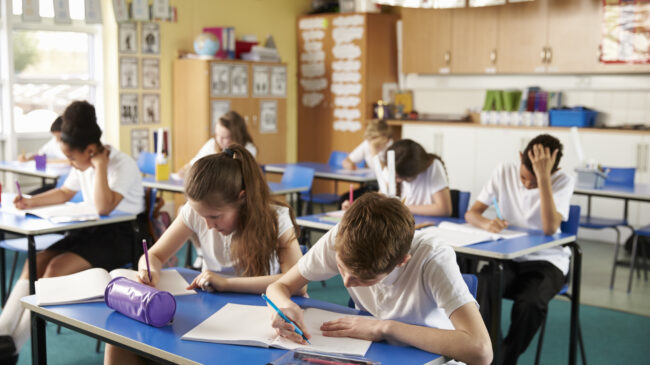As states grapple with education challenges such as making up for COVID-19 lockdown-related learning loss and the expiration of federal pandemic aid, they may want to look at how Florida is getting an impressive return on its public education funding. For other states, Florida provides a model for doing more with less by pushing public schools to compete for students. The state may spend less per student on K-12 education, but not at the expense of student achievement.
A new Reason Foundation study found that between 2002 and 2020, Florida’s inflation-adjusted education funding went from $10,707 per student to $11,526 per student, ranking only 43rd across all 50 states in both spending growth and overall per-student spending. Florida has partially kept public education costs under control by ranking near the bottom in spending on support services, a Census Bureau reporting category that includes school administrators, counselors, and central office staff. This type of support services spending per student increased by 25% nationally but grew by less than 5% in Florida.
Public school advocates would have you believe this is a surefire recipe for failure. But Florida’s standardized test scores not only improved over time but were among the best in the nation.
Reason Foundation’s study looked at every state’s math and reading scores for fourth and eighth graders on the National Assessment of Educational Progress exams between 2003 and 2019, the testing dates that most closely matched the spending data. Florida posted impressive test score gains, ranking in the top 10 states for growth in all four tests examined, and in 2019, its fourth graders ranked sixth nationally in reading and fourth in math.
Florida’s low-income fourth graders fared even better, placing first in the nation in both reading and math.
The strong test scores and improvements suggest Florida is putting its education dollars to good use, and with numerous reforms in the past two decades, it’s hard to boil that down to one single cause. But research suggests that one key factor is something that public schools in most states don’t have nearly enough of: competition.
Around 1.7 million of Florida’s students —or nearly half of all K-12 students statewide— participate in some form of school choice, such as education savings accounts, tax credit scholarships, charter schools, and open enrollment. Unlike in most states, public schools in Florida don’t have a monopoly over students and their funding. If public schools don’t live up to expectations, parents can leave at any time with many options from which to choose. Not only is this good for students, but research shows that it also pushes public schools to improve by putting the right incentives in place for them to do so.
In a recent report for Stanford University’s Hoover Institution, Patrick Wolf notes that 10 of the 11 studies examining the competitive effects of Florida’s private school choice programs find that “school choice in Florida consistently improves the achievement of students in affected public schools,” with only one study showing no significant effects.
An extensive 2023 study of the Florida tax credit scholarship program by David Figlio, Cassandra Hart, and Krzysztof Karbownik published in the American Economic Journal found that the more competition public schools faced for students, the better they performed over a 15-year period (the time frame nearly identical to the NAEP scores in Reason Foundation’s study). Competition led to improvements in test scores and other positive, measurable outcomes, such as declines in absenteeism and suspensions.
Wolf leaves no doubt about the benefits of competition, concluding, “The positive competitive effects of the launch or expansion of private school choice programs on system-wide educational outcomes is the most consistent finding in the entire field of school choice research.”
One takeaway for policymakers is simple: boosting student outcomes can be done without breaking the bank. Instead, states should implement school choice policies that break the public school monopoly by giving parents choices and schools incentives to improve. Competition is a win-win for students and public schools.
A version of this commentary first appeared in the Washington Examiner.

